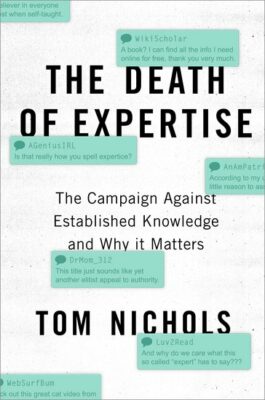There is no question that historians in their role as content experts experience failure. All humans are imperfect, and all historians are human, hence imperfect historians are not always on target.
Every professor and instructor is, in some way, a “content expert”—a cognoscente if you prefer some flourish. Courtesy of their historical explorations or their credentials, they know a great deal about small slices of the world. In my case, for instance, while I have inclinations to be the proverbial “fox” in Isaiah Berlin’s famous aphorism, I am a hedgehog when it comes to few topics. I am a content expert when it comes to the work of Mortimer J. Adler and the history of the great books idea, and in recent years have become something of a hedgehog on the topic of anti-intellectualism and some of the writings of, and about, Richard Hofstadter. In those arenas, I am susceptible to viewing the world through one or two big ideas. But my larger point remains: all historians are experts in something. Yet even so they can, and do sometimes, fail.
Historians fail by telling mediocre or bad stories, performing less than thorough research, and engaging in personal and professional misconduct. My interest, for the present, is neither personal misconduct (e.g., sexist behaviors, racism, or harassment) nor mere failures in style. I am also not interested, for now, in bad or outrageous personalities—whether in terms of quality or quantity. Also, I would rather avoid the discussion of famous cases of historians’ failures (i.e., Ambrose, Goodwin, Bellesiles, etc.). Finally, I would like to bracket professionals who are, somehow, also Holocaust Deniers. All of these are legitimate topics in the realm of historians’ failures, and I may get to them in future posts.

But I want to focus on a few specific aspects of our profession’s failures. Courtesy of a recent reading of Tom Nichols’ The Death of Expertise: The Campaign against Established Knowledge and Why It Matters (Oxford, 2017), the general discussion that interests me most are failings in academic/professional conduct as related to three arenas: stories, research, and historians’ ‘standing’. Nichols imported a scientific initialism that covers some of these categories: FFP – Fabrication, Falsification, and Plagiarism (p. 179).
Before diving too deeply into these three areas, a pertinent distinction to keep in mind—one you’ve probably already been considering—is between accidents and purposed bad behavior.
Imperfect historians have accidents. They forget footnotes/endnotes, improperly cite sources, and forget to include quotes around pertinent material. They neglect dates, is misname things or people. These are usually one-time or infrequent issues. They indicate a lack of care or negligence. A prudent professional would not make the error, and it’s a failure. But these issues do not mean that one is a general failure as a historian. The historian either catches or is informed of the problem, and corrections are made—either to the text or in one’s behavior. A few high-profile historians have failed in these ways (i.e., been subject to charges of plagiarism) and have continued, with success, in the realm of publication and public appearances. Mistakes were made. The general public seems to be more tolerant of these “minor” irregularities than is the historical profession itself. Historians have long memories.
I have not seen a professional society—the AHA, OAH, or even S-USIH—officially put a member on probation, or subject them to a watch status due to the aforementioned accidents. Professional history organizations are not generally given to naming and shaming. But these options are most certainly on the table in the case of negligence or error, depending on the severity of the event in question. Nichols’ reminds his readers that it is indeed a key responsibility of professional societies to police members who violate respective codes or ethics or conduct. This Society (S-USIH), for instance, has no general code of ethics for research or academic matters, but we do have a code of conduct in place for conference and blog interactions (events and gatherings, covering harassment, bullying, etc.).
While the issues I’ve outlined thus far can be quite serious and have consequences, it gets trickier in the realm of falsification and fabrication with regard to storytelling. When does a story fail? How? What criteria are used to judge?
The easiest criteria by which to judge whether a story has failed is research—evidence and notes. If the notes are missing or nonexistent, this makes judgments either really easy or exceedingly difficult. Let’s assume, for the moment, that notes and references are present. Historians like to see a mix of primary and secondary sources. The former shows a grounding in evidence from the period (e.g., institutional or personal papers, newspaper accounts from the period, oral histories, repositories, material culture items). The latter displays one’s mastery in the pertinent historiography and theory (e.g., historical accounts that have varied, philosophical approaches, unique individual storytelling angles).
If the sources are unbalanced, there is usually some weakness present. A history reliant on secondary sources may display the distortions of several human filters. A historical account entirely based on primary resources may lack some philosophical depth, or the richness attendant to competing reconciled narratives. The richness of variety allows for cross-checking facts and triangulation of events. The story is less likely to fail because its evidence is reliable.
Notes enable the possibility of replication by colleagues, which helps protect against falsification and fabrication. It must be stated with some emphasis that the process of replication is not about creating a carbon copy. With good notes the story from another can only be approximated. Notes do not predict a narrative. Notes do, however, help reveal whether a source was used properly and with some justice. In the context of history, falsification consists of having and citing a legitimate source but using it improperly. When a reader, especially another professional historian, can find and check they source, they can judge whether the author’s use and interpretation falls within the range of plausible. They can approximate not just the the account but also the interpretation. The presence of notes, then, helps show that you have not falsified evidence to fabricate a work of historical fiction. This possibility of replication shows the world how history is a social science.

While plagiarism is not prevented by good notes, the willingness to be explicit about notes helps. Notes offer the reader some assurance that your historical account acknowledges source overlap, or reveals unique sources. This helps the reader or fellow professional have confidence that you are not pretending to be unique. Plagiarism is, of course, also about the direct or nearly-direct lifting of passages from another without acknowledgement. This is obviously a strict no-no, and direct evidence of the failure of a historian. But this problem recurs due to the vastness of our information networks and deposits (i.e., no one can know or remember all existing historical narratives, sometimes even in more specialized arenas). Plagiarism is a consequence of social and professional pressures to be productive, creative, and unique.
Apart from bad or missing notes, and plagiarism, a failed story may result from: a flawed thesis, a focus on the wrong characters, odd evidential selection criteria, or the presence of too much ideology over evidence. These problems are, again, not necessarily the result of malfeasance. For instance, a story strongly infused with ideology may be an honest effort to foster a new perspective. A lot of Marxist histories focus on economic factors that highlight the role of capitalist ideas and structures on historical events. Poststructuralist stories that focus on language highlight how different unconscious factors may be in play—factors that may structure an outcome, foreclosing certain options. These kinds of stories (Marxist, postmodern) reveal contingent moments, or significant characters, otherwise taken for granted. But some ideologically-driven stories deliberately avoid significant evidentiary factors, making their stories highly flawed—potentially more fictional than objectively realistic.
The failures of historians underscore the need for professional judgment. Other historians, either independently or in the context of professional societies, are best equipped to make judgments of failure, mistakes, errors, injustices, misconduct, and malfeasance. Our overlapping networks of professional societies sift the credentials, experience, education, and behavior of members. They also run peer-reviewed journals that vet articles and books—not just for baseline criteria but also for superlative works. Societies of expert peers assess and discuss norms for application in the profession. Societies insure the labor of professional historians.
The intellectual insurance of professional societies and their mechanisms of peer-review still, however, don’t fully prevent the occurrence of mistakes and errors. Given the work of our aforementioned poststructuralist historians, we know that societies are structured by common assumptions and blind spots. There is an irreducible amount of play, or elasticity, in our peer activities. A group of smart historians can still miss important errors and failures. Groupthink is possible.
But all professional work, in history and beyond, carries with it some risk. Errors cannot be eliminated, but they can be minimized. Our societies help keep the risks minimal, reducing the number of failures among historians. This helps maintain the public trust. The work of societies in maintaining standards of expertise assists in keeping confidence high. It’s a necessary and never-ending endeavor. Only constant vigilance by a robust, pluralist profession can insure good work and protect readers, and citizens, from the failures of historians.

0